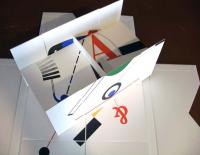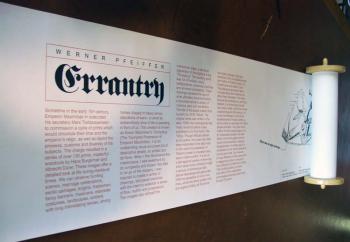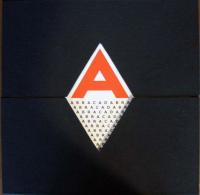The sculptor and book artist Werner Pfeiffer is currently installing an exhibition of his work down the road at the University of Pennsylvania, opening Thursday, September 17, 2009, at 5:30 p.m. http://www.library.
upenn.edu/exhibits/pfeiffer.html. This seems like a good opportunity to mention two recent acquisitions of Mr. Pfeiffer’s work in the graphic arts collection at Princeton University.
Errantry is a scroll inspired by Der Triumphzug Kaiser Maximilians or The Triumphal Procession of the Emperor Maximilian (1515), a series of 130 woodcuts by Hans Burgkmair the Elder (1473-1531) and others. Pfeiffer has created his own militant parade of 20th-century violence and agression.
The title and text are based on a poem written by J.R.R. Tolkien in the 1930s, thought by many to be about war. The poem used in this scroll is an adaptation with only two or three lines directly quoting the original but with the syntax, rhyme, and meter of Tolkien’s writing.
The text and images are set against a chilling chronology of war, conflict, and genocide in the 20th century, printed digitally on a 27 foot long canvas. The scroll is housed in an actual 105 mm Howitzer artillery brass casting, manufactured for use in the M14 gun in 1943.

“Abracadabra is a book about magic,” writes Pfeiffer, “Not the illusory trickery of a conjuror, but the magic of an artist’s work.” It is an homage to Dutch graphic artist and resistance fighter Hendrik Nicolaas Werkman (1882-1945), who was executed by the Nazis in the waning days of World War II. In particular, it is a recognition of the inventive typographic works Werkman called drucksels. These unusual pieces combine letterforms with geometry and color. Pfeiffer has created a set of designs based on the letterforms of Abracadabra both in individual plates and in three flexagon structures that can be folded and flipped into multiple forms of fabulous visual geometry.



